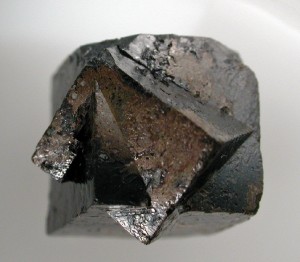Magnesium silicate perovskite is the most abundant silicate in our planet. Never given a mineral name in its own right, it is unstable at Earth’s surface and has only been observed directly in the lab, rather than the field. So it fails to meet the criteria set down by the masters of mineral names, the International Mineralogical Association. Instead it adopts that given to calcium titanate, a rather rare and obscure mineral named after a similarly obscure Russian count and nineteenth century mineral collector.

Natural perovskite from Perovskite Hill, Magnet Cove, Hot Spring County, Arkansas, USA, photo credit: Kelly Nash, wikimedia commons
The adopted family of compounds named after perovskite have, however, taken an importance far beyond that minor titanate accessory mineral. As well as dominating the geophysical and geochemical properties of Earth’s lower mantle, a whole raft of technological materials with the perovskite molecular structure have found applications in our modern world. First recognised for as transducers in submarine microphone systems their first applications were during the second world war, when they formed an important part of sonar detectors, for the atomic dance that perovskites perform converts stress to electric charge, and vice versa. Perovskites are used as transducers in sound systems, microphone pickups, electronic loudspeakers, and are essential components in your mobile phone. But oxides with the perovskite structure have also been used in non-volatile computer memory (PlayStationII memory cards are perovskite), in magnetic devices, and even in the humble gas lighter, generating the ignition spark.
Most recently, methylammonium perovskite has been proposed as a light harvester for dye-sensitised solar cells, the next generation of cheap, thin film, flexible, low-embedded-energy photovoltaic devices for solar energy production.

Dr Julia Percival adjusts the knitted perovskite model at Surrey University, UK. Photo credit: Simon Redfern
Now the University of Surrey Department of Chemistry have given the perovskite story a new take. Their “Perovskite Project” aims to build a knitted version of the molecular structure of perovskite. Knitters and crocheters from across the world can contribute to this model, with knitting patterns for the perovskite structural units … the oxide octahedra and cation central sphere, available to download . They will be collecting contributions in August and assembling the giant knitted perovskite later in the summer.
I interviewed Dr Julia Percival, leader of the Perovskite Project, for BBC World Service Radio earlier in the month, hear more here, and Get knitting!

